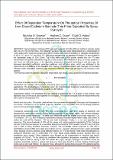| dc.contributor.author | Nicholas O Ongwen, Erick Ogam, Henry O Otunga | |
| dc.date.accessioned | 2020-12-10T14:53:56Z | |
| dc.date.available | 2020-12-10T14:53:56Z | |
| dc.date.issued | 2020 | |
| dc.identifier.uri | https://repository.maseno.ac.ke/handle/123456789/3392 | |
| dc.description.abstract | The elastic properties of the orthorhombic cadmium stannate (Cd2SnO4) were investigated using density functional theory, applying both energy-strain relationship (which is found in the literature) and stress-strain relationship (which we have developed in this study), both in the generalized gradient approximation and local density approximation (LDA) as implemented in the Quantum Espresso code. The results from both methods were found to be in good agreement with each other. However, the values for the stress-strain calculation were found to be relatively higher than those of the energy-strain and also, were those obtained from the LDA. The study found out that Cd2SnO4 possesses desirable elastic properties that are comparable to those of silicon, the dominant substrate material used in the manufacture of Microelectromechanical Systems. The bulk modulus was found to be nearly twice (more than 1.5 times) that of Si. Moreover, the material was found to be ductile, which when combined with the transparent nature that has been studied earlier and is available in the literature, can form a better substrate for the manufacture of transparent and flexible MEMS such as cardiopulmonary sensors, microbolometers, temperature and pressure sensors. | en_US |
| dc.publisher | Elsevier | en_US |
| dc.subject | Mechanical properties of cadmium stannateCadmium stannate as a MEMS materialab initio study of cadmium stannateDuctility of cadmium stannate | en_US |
| dc.title | : Spray Pyrolysis Technique (SPT) was used to deposit thin films (TFs) of cadmium stannate, doped with iron (Fe) for the first time. The precursor solutions that were used wereprepared at a concentration of 0.1M, doped with Feand then sprayed onto the pre-heated glass slides immediately at deposition temperatures of 350 ± 7°C, 400 ± 7°C and 450 ± 7°C. The optical properties of the deposited Fe-doped TFs were studied in the wavelength range of 300-1100nm. The X-Ray diffraction (XRD) studies showed that the TFs were orthorhombic with growth orientation along the (2 0 0) direction. Film thickness of 85 ± 10 nm was obtained. It was found out that anincrease in the deposition temperature increased transmittance and band gap, but decreased absorption coefficient, extinction coefficient and refractive index, which was attributed to the improvement in crystallinity of the deposited TFs. Doping reduced transmittance and band gap, but increased refractive index, absorption coefficient and extinction coefficient, which was attributed to the increase in free carriers. KEYWORDS:cadmium stannate, deposition temperature, iron-doped, optical properties of cadmium stannate | en_US |
| dc.type | Article | en_US |

